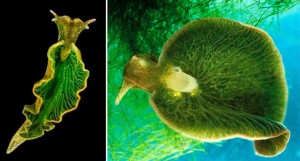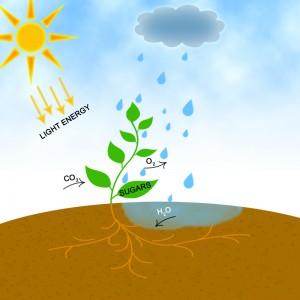We have learned that photosynthesis is an inherent characteristic of plants reserved for their survival by collection of sunlight as a means to their survival, but what would you say when there is an animal living on photosynthesis? Prepare to get your socks knocked off by what is about to come because this is an introduction to the sea slug literally living off the solar power.

Sea-Slug, Elysia chlorotica
From Pedro Jorge Peu (pinterest)
Photosynthesis is a process that generates sugar by absorbing the sunlight. More specifically, chloroplasts which are the food producers of the cell converts light energy of the sun into sugars that can be used by cells. It is a process thought to be reserved for the Kingdom of Plantae, eukaryotic, and multicellular organisms. Imagine a solar panel powering electricity to charge our cell phones; plants absorb their energy in a similar way too.

Photosynthesis From Flickr Commons
Kingdom of Animalia on the other hand, derives from the Latin word Animalis literally meaning “having breath”, they are eukaryotic, multicellular, and do not survive relying on photosynthesis. However, in 2010, CBC news reported that in the case of the brilliant emerald green coloured sea slug Elysia chlorotica, it is not the case.
The photosynthesizing sea slug lives by the incorporation of chloroplasts within the cells which allows it to capture energy directly from sunlight as most plants do, through the process of photosynthesis. What was thought to be exclusive to plants is not the case due to the discovery of organisms such as E. Chlorotica. Generally speaking, it will have algae for its food supply, but if they are not readily available, these slugs will survive and function for up to nine or even ten months by the sugars produced through photosynthesis performed by their own chloroplasts.
[Credit to FORA.tv]
In a study, it was found and proven that these slugs definitely have a way to support the survival of their chloroplasts. After the eight month period of its survival without readily available food source, “the majority of the chloroplasts within the slugs appeared to have remained intact and also maintaining their fine structure.” They do this by not spending their precious energy on activities involving finding food but staying intact synthesizing their own chloroplasts; ability acquired from yellow-green alga (Vaucheria Litorea). The studies are on-going for this slug as scientists are researching for its potential genes that could support chloroplast survival and photosynthesis.
Even after all this, they are still not truly photosynthetic organisms. Last year, Gregor Christa and his researchers reported that as E. Chlorotica can survive in dark environment which is why they still belong to the Kingdom Animalia. Animal or plant, it may be up to how the reader may decide. I decide on classifying this beauty as an animal true to its purpose; survival.
Grace Kim


One response to “Solar Powered Sea Slug: Power of Photosynthesis!”